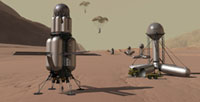| Nov 29, 2013 | |
Bringing Martian technology down to Earth |
|
| (Nanowerk News) An EU-backed project is adapting inflatable technology developed for Mars missions to bring objects in space back down to Earth. | |
 Overcoming gravity to send objects into space was one of the greatest scientific challenges of the 20th century. A related, albeit far less Earth-shattering challenge is to bring objects in space back down in a way that overcomes atmospheric friction — which can generate temperatures of hundreds of degrees Centigrade — without causing undue damage. With EU funding, the 'Re-entry: Inflatable technology development in Russian collaboration' (RITD) project is trying to establish whether a re-entry system developed for Mars can be adapted to work on Earth for low-mass payloads. The Martian system is based on cutting-edge technology, developed by a project partner, and involves inflatable structures, which are more compact than conventional structures. With scientists from the EU and Russia, RITD is studying the feasibility of using the partner-developed entry and descent system, allowing for scaling modifications, for objects in low-Earth-orbit. In particular, the project is analysing, via simulations and wind tunnel testing, the stability of the system during the supersonic and transonic phases of the descent. During RITD's first phase, an in-depth analysis of existing technologies revealed a clear demand for this type of inflatable re-entry technology. In addition, initial assessments show that, although this technology was developed for use on Mars, it can work well in Earth's atmosphere too. It simply requires the addition of a small pressurising device to protect the inflatable system against Earth's greater atmospheric pressure. |
|
| The project's entry, descent and landing system stands to become a leading candidate for future missions. The project is also helping to strengthen Euro–Russian collaboration in space. |
| Source: Cordis |
